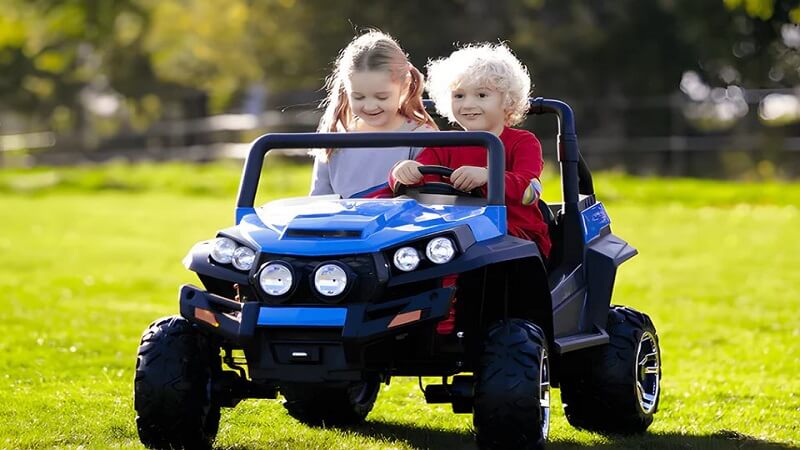When it comes to outdoor play that blends excitement, learning, and mobility, ride-on cars have become a staple in many Canadian households. But with so many models available today, selecting the right one — especially a two-seater — can be more complex than it first appears. From age-appropriate features to terrain compatibility and safety functions, the decision involves more than just picking a stylish model.
If you’re considering investing in a 2 seater ride on car for your little ones, here’s a comprehensive guide to help you make an informed and thoughtful choice.
Understand Your Child’s Development Stage
The first and most critical consideration is your child’s age and physical development. Ride-on cars are typically categorized by age ranges — toddlers (2–3 years), preschoolers (4–5 years), and early school-aged children (6–8 years). Each group requires different specifications. Toddlers, for example, need lower speeds and simple steering, while older children can handle faster models with more complex controls.
Always check the manufacturer’s recommended age and weight limits. Exceeding them could compromise safety and performance.
Prioritize Safety Features from the Start
A high-quality two-seater ride-on vehicle should offer multiple built-in safety features. Seatbelts are a must — ideally adjustable, to accommodate different body sizes. Parent remote controls are invaluable, especially for younger children, allowing caregivers to take over at any time. Emergency stop buttons, slow-start functions, and soft braking systems are also worth prioritizing.
Check if the ride-on meets Canadian safety standards, such as CSA certification, which ensures materials and design are rigorously tested for child use.
Choose the Right Power Configuration
Ride-on cars generally come with 12V, 24V, or 36V battery configurations. For most two-seater models, a 24V battery strikes a good balance between speed and endurance — enough for older kids and mild off-roading. However, younger children may do better with a 12V model for a gentler introduction.
Battery life varies by terrain and usage, so consider runtime and charging requirements. Some models now offer replaceable or dual-battery options, extending playtime considerably.
Consider Interior Space and Seat Design
Not all two-seaters are equal in terms of seating space. Some models market themselves as “2-seater” but are better suited for one child and a passenger, while others offer full-size dual seating with individual seatbelts. If your children are close in age and size, look for cars with equal-sized, padded seats for comfort during longer rides.
The quality of the upholstery — whether it’s EVA foam or leather-like trim — can also make a significant difference in both comfort and aesthetics.
Match the Wheels to the Terrain
Wheels determine how well the ride-on car will handle different surfaces. For smooth indoor or paved surfaces, plastic wheels with traction bands may suffice. But for gravel, grass, or uneven terrain, rubber or EVA foam tires with suspension systems are essential for shock absorption and control.
Four-wheel drive models are ideal for off-road fun, providing extra torque and grip for tougher terrain, especially if you live in a more rural or snow-prone region.
Look at Speed Options and Driving Modes
Speed isn’t just about thrills — it’s about control. For beginners, ride-on cars with multiple speed settings allow parents to start slow and gradually increase as the child becomes more confident. Many vehicles come with two to three speed modes, and some have reverse functions or manual/automatic shifting features.
Dual motors provide a smoother driving experience, and models with realistic gear levers or dashboards can also enrich your child’s imaginative play.
Explore Entertainment and Tech Add-Ons
Today’s ride-on cars are more than just toys — they’re tech-savvy machines. Many models feature working headlights, horn sounds, USB/MP3 connectivity, Bluetooth, and even touchscreens. These features not only keep children entertained but also simulate real-life driving experiences.
That said, avoid overloading on features that may distract younger drivers or unnecessarily drain the battery. Prioritise usability over novelty.
Factor in Storage, Charging, and Maintenance
Practical considerations like garage space, charging convenience, and general upkeep often go overlooked. Make sure you have a designated area to store the vehicle away from harsh weather. Some models allow for easier battery removal and replacement, while others require full disassembly.
Cleaning is another aspect — models with splash-proof bodies and enclosed wheel wells are easier to maintain, especially after a muddy adventure.
Think About Longevity and Resale Value
A two-seater ride-on car is an investment. Choose a model with a sturdy frame, quality materials, and a reputable service warranty. Some higher-end models hold their resale value well, especially if kept in good condition.
Opt for brands that offer spare parts and customer service support in Canada. This ensures you won’t be left with a non-functional toy due to an unavailable replacement battery or controller.
Final Thoughts on Finding the Perfect Fit
Selecting the right ride-on car requires balancing excitement with safety, and novelty with practicality. A well-chosen model can offer not only joyrides but also developmental value — enhancing coordination, social interaction, and even basic road awareness.
The right two-seater will grow with your child, adapt to your environment, and deliver countless hours of outdoor fun. By focusing on the features that align with your child’s needs, you can confidently choose a vehicle that’s as safe and enriching as it is fun.

